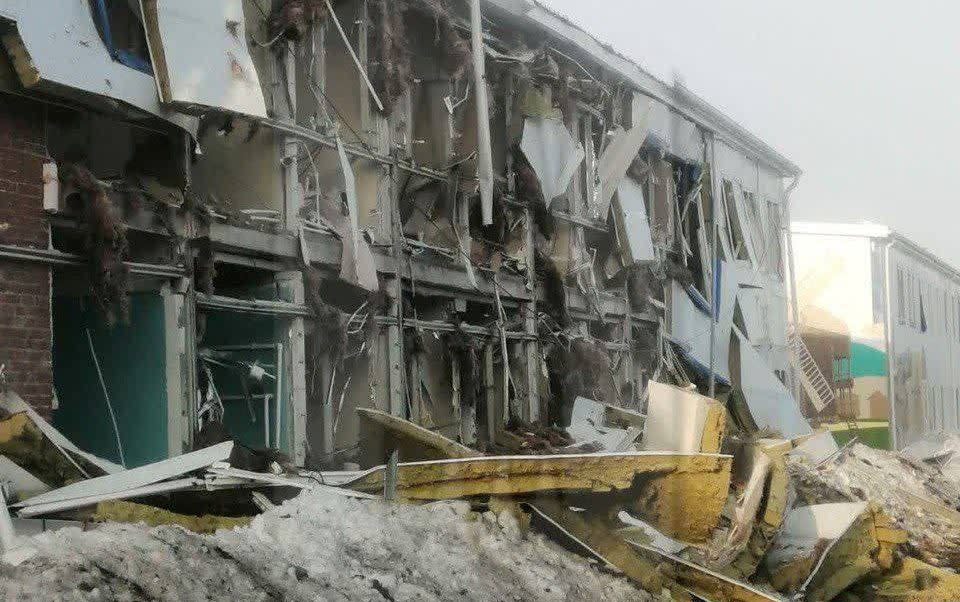Watch: Ukraine flies aircraft packed with explosives into Russian drone factory
Ukraine flew what is thought to be a light aircraft packed with explosives into a factory assembling drones in the “deepest strike inside Russian territory” since the start of the war.
The “drone aircraft” strike on Russia’s central Tatarstan region – hundreds of miles from the countries’ shared border – hit a building believed to contain dormitories for workers near a factory assembling Iranian Shahed explosive drones in the town of Yelabuga.
It wounded 13 people, including two students and two minors, according to local health officials.
Another attack targeted an oil refinery in Nizhnekamsk. The sites are more than 800 miles (1,300km) from the border.
Videos on social media showed an aircraft-style drone flying into a two-storey building at a business park outside Yelabuga before exploding, sending a fireball into the air.
Kyiv has regularly hit Russian territory since the start of Moscow’s invasion, but generally not far from the border. The cheap Shahed drones, initially imported from Iran, have been pivotal to Russian attacks on Ukrainian energy facilities.
On Monday, Mykhailo Fedorov, Ukraine’s digital minister, who is involved in the country’s drone programme, said the country had recently developed its own drones that can fly more than 620 miles.
“Most of the drones that attacked Russian oil refineries have a range of 700-1,000km, but now there are models that can fly more than 1,000km,” he said.
However, this drone appears to have travelled even deeper into Russian territory. According to Ukrainian sources, it was a “new model” with a range at least 200km longer than the Lyutyi drones, which have a maximum reach of 1,000km.
Observers pointed out that it resembled an Aeroprakt A-22, a Ukrainian two-seater, high-wing ultra-light aircraft.
Sam Guichelaar, a pilot, flight instructor and flight operations manager, said: “Genuinely just looks like an Aeroprakt A-22 training aircraft, which may make sense if they launched it from within Russia – which seeing the distance from UA is logical.”
He suggested it had perhaps taken off from inside Russia, adding: “Much easier to convert an existing aircraft into a drone than to smuggle an entire massive drone into Russia.
“For the record: The A-22 cruises at around 110 knots. That means it would have been flying for at least six hours (shortest straight line route) over Russian territory, at a slow speed, without being noticed/shot down. I think it’s likelier it was launched closer to the target.”
Dmitry Peskov , the Kremlin spokesman, said: “The Kyiv regime continues its terrorist activity. Our military is working to minimise this threat and then completely eliminate it.”
The region’s health ministry said eight people were in hospital in a “mild to moderate condition” and that there was “no threat to their lives”.
In the Russian city of Nizhnekamsk across the Kama river from Yelabuga, the RIA Novosti state news agency said a drone hit the Taneco oil refinery, owned by Tatneft, the Russian oil giant.
A unit that processes about 155,000 barrels of crude a day was struck, though an industry source said the damage was not significant.
Russian officials said its jamming devices locked onto a Ukrainian drone near the refinery, which has an annual production capacity of more than 17 million tons, or 340,000 barrels, a day.
Pictures from the scene indicated that the drone hit the primary refining unit, CDU-7, though the drone appears to have not done serious damage. Tatarstan officials said a resulting fire was put out within 20 minutes and did not disrupt industrial production .
Ukrainian officials said intelligence services were involved in the overnight attack. The country has claimed responsibility for several drone strikes on oil refineries in Russian territory, saying they are a legitimate retaliation to Moscow’s targeting of its energy facilities.
Sergei Shoigu, the Russian defence minister, said Kyiv was trying to divert attention from its military setbacks by attempting to strike Russian territory “to persuade its Western sponsors that it remains capable to confront the Russian military”.
Speaking during a meeting with the top military brass, Mr Shoigu claimed Russian troops have gained more than 155 square miles since the start of the year.

Meanwhile, on Tuesday, Russia named the new head of its troubled Black Sea Fleet following a spate of Ukrainian attacks on its military ships.
Kyiv claims to have destroyed a third of Russia’s vessels in the Black Sea since Moscow launched its offensive more than two years ago. The losses are a major embarrassment and setback for Russia’s military even as its troops advance on the ground.
The appointment of vice-admiral Sergei Pinchuk as commander of the Black Sea Fleet comes as part of a wider shake-up of Russia’s navy, including the appointment of a new overall commander-in-chief, admiral Alexander Moiseyev.
Antony Blinken, the US Secretary of State warned on Tuesday that Ukraine is at a “critical moment” and urgently needs more Western support, bemoaning the stalemate in Congress over a multi-billion dollar military package for Kyiv.
Joe Biden has urged the Republican-controlled US House of Representatives to endorse the military and financial aid package, but Mike Johnson, the House Speaker has held up the matter for months, citing domestic priorities.
Volodymyr Zelensky, the president of Ukraine, has said that his forces will have to retreat “in small steps” if his country does not get the aid.


 Yahoo News
Yahoo News 
